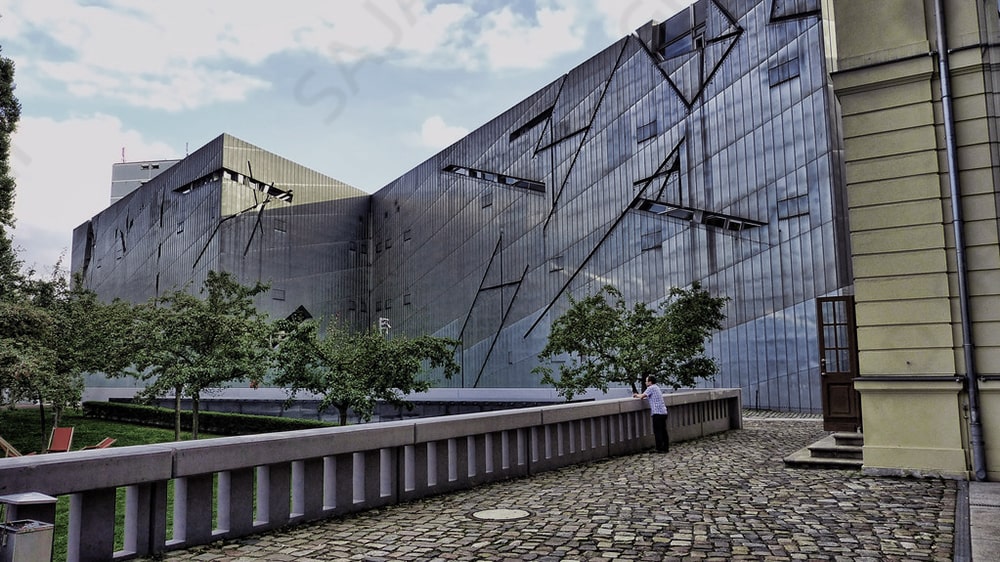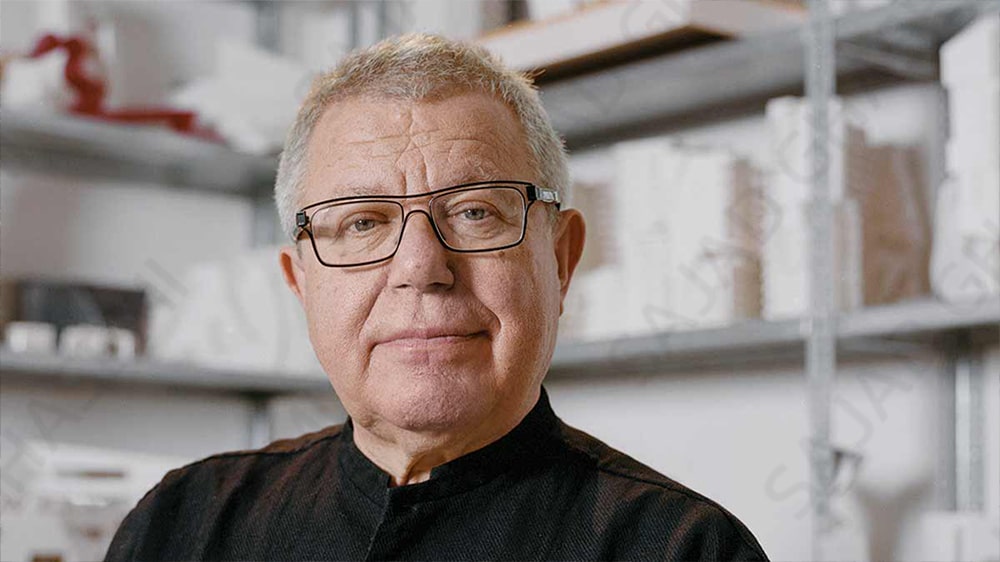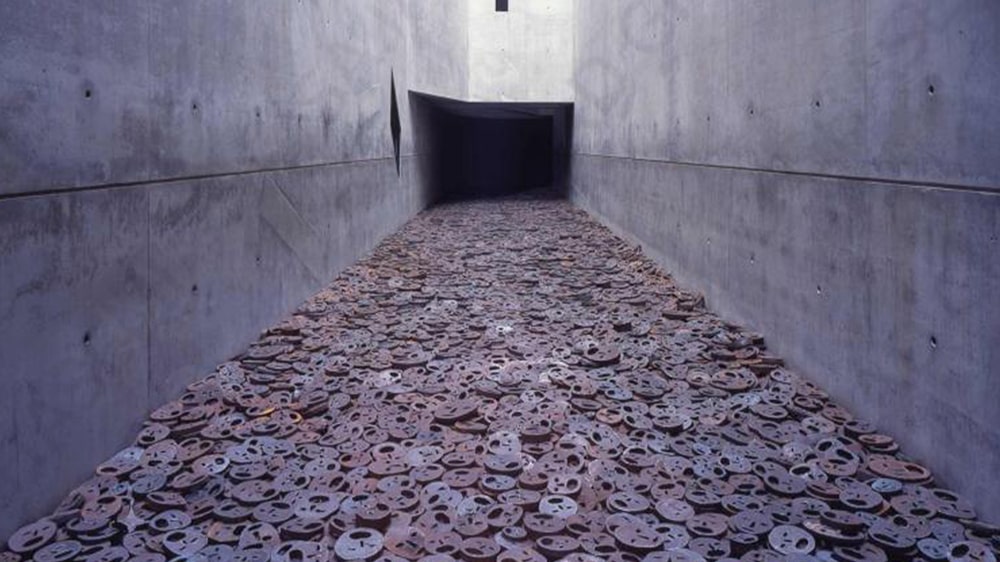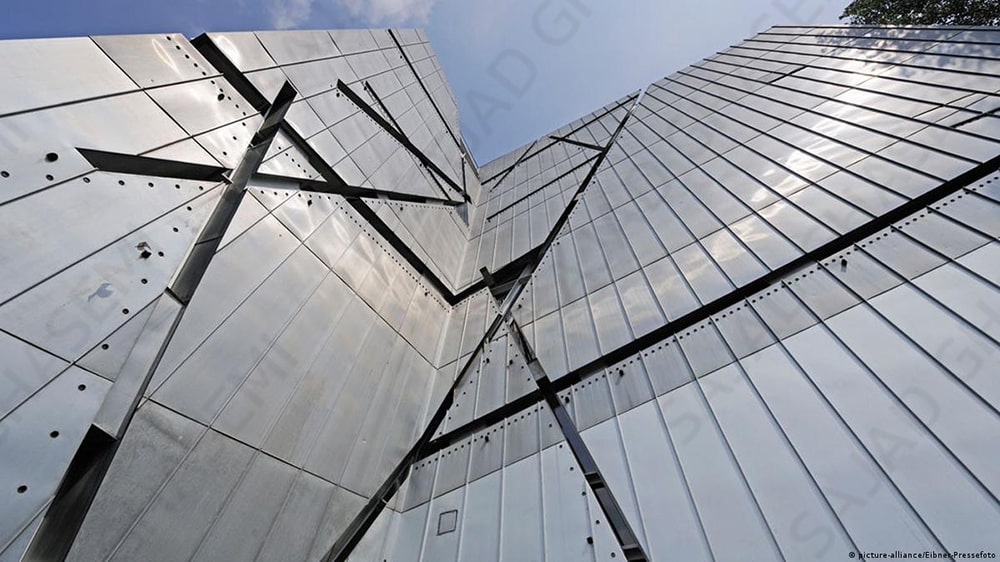
With its striking zigzag design and deeply symbolic form, the Jewish Museum in Berlin stands as one of the most powerful and thought-provoking architectural creations of the modern era. Designed by the renowned architect Daniel Libeskind, this museum is far more than just a building to house exhibits – it is a profound work of art that challenges visitors to confront the complex history and identity of the Jewish people in Germany.
Daniel Libeskind: Architect of Memory and Resilience
In the realm of contemporary architecture, few names evoke as much awe and admiration as Daniel Libeskind. This Polish-American architect has left an indelible mark on the world with his bold, unconventional designs that transcend mere aesthetic appeal and delve into profound realms of history, memory, and identity.
Born in Poland and Shaped by History
Daniel Libeskind’s journey began in Lodz, Poland, in 1946, just a year after the devastating conclusion of World War II. As a child of Polish-Jewish Holocaust survivors, his formative years were indelibly shaped by the trauma and resilience of his family’s experiences. This profound connection to history and memory would become a driving force in his architectural vision.
A Multifaceted Education and Early Career
Libeskind’s intellectual curiosity and creative talents were nurtured from an early age. After immigrating to Israel with his family in 1957, he went on to study music and eventually earn a degree in architecture from the Cooper Union in New York City. His diverse background in disciplines such as music, philosophy, and literature equipped him with a unique perspective on the intersections of art, culture, and the built environment.

In the 1970s and 1980s, Libeskind taught at various universities, including the University of Toronto and Cranbrook Academy of Art, while also pursuing architectural projects and theoretical explorations. His early work, including the iconic “Micromegas” series and the “Countersign” project, showcased his unconventional approach to architectural form and his ability to infuse built spaces with layers of meaning.
Breaking Through: The Berlin Jewish Museum
It was Libeskind’s remarkable design for the Jewish Museum in Berlin that catapulted him to international acclaim and cemented his reputation as a master of symbolic architecture. Chosen from a pool of 165 entries in 1988, his bold and fragmented design for the museum extension captured the profound sense of dislocation and loss experienced by the Jewish community during the Holocaust.
The museum’s striking zigzag form, punctuated by the powerful “Void” that cuts through the building like an invisible wound, created a profound spatial experience that challenged visitors to confront the weight of history and the resilience of the human spirit. This masterpiece not only won numerous awards but also established Libeskind as a pioneering voice in the realm of architectural storytelling.
Architectural Landmarks Around the World
Following the success of the Berlin Jewish Museum, Libeskind’s unique talents were sought after for a diverse array of projects around the globe. From the poignant Imperial War Museum North in Manchester, England, to the soaring Contemporary Jewish Museum in San Francisco, his buildings have become landmarks that celebrate cultural identity and provoke profound contemplation.
Other notable works by Libeskind include the Royal Ontario Museum in Toronto, the Military History Museum in Dresden, and the masterplan for Ground Zero in New York City, where he designed the poetic Freedom Tower and memorialized the tragic events of 9/11 through his architectural vision.
Pushing Boundaries and Challenging Conventions
What sets Daniel Libeskind apart is his unwavering commitment to pushing the boundaries of architecture and challenging conventional notions of form, space, and meaning. His buildings are not mere functional structures; they are deeply symbolic narratives that engage with the complexities of human experience, memory, and identity.
Through his innovative use of angles, fragmentation, and unconventional geometries, Libeskind creates spaces that disorient and provoke, inviting visitors to confront their perceptions and engage with the deeper layers of meaning embedded within his designs.

A Lasting Legacy and Influence
At the age of 76, Daniel Libeskind shows no signs of slowing down. His ongoing projects, including the Ngaren Museum of Humankind in Kenya and the Bora Residential Tower in Mexico City, continue to push the boundaries of what architecture can achieve.
But beyond his built works, Libeskind’s true legacy lies in his profound impact on the architectural discourse and his ability to inspire future generations of designers. His teachings, writings, and lectures have challenged conventional thinking and encouraged architects to embrace a more holistic and culturally responsive approach to their craft.
In recognition of his contributions, Libeskind has received numerous honors, including the Hiroshima Art Prize, theNcia alla Carriera Prize, and the prestigious Wolf Prize in Arts. His influence extends far beyond the realm of architecture, as his works have been celebrated in the worlds of art, literature, and philosophy.
As the world continues to grapple with issues of identity, memory, and cultural heritage, Daniel Libeskind’s architectural creations stand as enduring reminders of the power of art to heal, provoke, and uplift the human spirit. Through his masterful manipulation of form and space, he has given voice to the stories that shape our collective consciousness and challenged us to engage with the complexities of our shared existence.
The Origins: A Competition to Memorialize Jewish Life
In 1988, an ambitious competition was launched to design an extension to the Berlin Museum with a Jewish Department. The goal was to create a space that would not only display Jewish history and culture but also serve as a poignant memorial to the victims of the Holocaust. From a pool of 165 entries from architects around the world, Libeskind’s unconventional and daring design was selected as the winner.
Libeskind’s Concept: An Emblematic Architectural Vision
Daniel Libeskind, a Polish-American architect of Jewish descent, approached this project with a deep personal connection and a powerful creative vision. His design for the Jewish Museum was heavily influenced by the idea of giving physical form to the void left by the near-obliteration of Jewish life in Berlin during the Holocaust.
The museum’s striking zigzag shape, composed of interconnected yet fragmented spaces, symbolizes the profound disruption and dislocation experienced by the Jewish community. The building’s slanted walls and angled floors create a sense of disorientation and unease, reflecting the unsettling experiences of those persecuted and displaced.

The Exhibition Spaces: Curating Memory and Identity
While the architecture itself is a powerful statement, the museum’s exhibition spaces also play a crucial role in exploring Jewish history and culture. The permanent exhibition, titled “Two Millennia of German-Jewish History,” takes visitors on a chronological journey through the triumphs, struggles, and tragedies of the Jewish community in Germany.
Through artifacts, documents, and multimedia installations, the exhibition sheds light on the rich cultural contributions of Jews in Germany, as well as the devastating impact of the Holocaust. Interactive displays and immersive environments encourage visitors to engage with the material on a deeply personal level.
Special exhibitions and temporary shows further enrich the museum’s offerings, exploring diverse aspects of Jewish identity, art, and contemporary issues. These rotating displays ensure that the museum remains a dynamic and ever-evolving space for dialogue and discovery.
The Impact: A Catalyst for Reflection and Healing
Since its opening in 2001, the Jewish Museum Berlin has become a landmark destination for visitors from around the world. Its profound architectural expression has captivated architects, critics, and the general public alike, earning numerous awards and accolades for its daring design and powerful symbolism.
But beyond its aesthetic and architectural merits, the true impact of the Jewish Museum lies in its ability to provoke contemplation and foster understanding. By confronting visitors with the complexities of Jewish history and identity, the museum encourages reflection on themes of displacement, oppression, and resilience that resonate far beyond the Jewish experience.
For many, the Jewish Museum serves as a poignant reminder of the importance of remembrance and the dangers of hatred and intolerance. Its very existence stands as a testament to the enduring spirit of the Jewish people and their indelible place in the fabric of German society.
In the words of Daniel Libeskind himself, “This building is not about representing or describing anything. It’s about giving form to memory, invisible memory, memory that is underground, memory that is in the air.” Through his masterful architectural creation, Libeskind has given tangible form to the intangible essence of Jewish identity, ensuring that the memory of the past remains ever-present and a guiding force for the future.
As visitors wander through the museum’s complex spaces, they are invited to confront the weight of history, contemplate the richness of Jewish culture, and emerge with a deeper understanding of the human experience. The Jewish Museum Berlin is not just a building – it is a profound architectural statement that challenges us to engage with our collective past and shape a more just and inclusive future.
Conclusion
The Jewish Museum Berlin stands as a testament to the power of architecture to transcend mere physical form and evoke profound emotions and insights. Daniel Libeskind’s masterpiece is a poignant reminder of the resilience of the human spirit and the importance of confronting our collective history, both in its triumphs and tragedies.
Through its striking zigzag design and powerful symbolism, the museum challenges visitors to engage with the complexities of Jewish identity, displacement, and oppression. The “Void” that cuts through the building serves as a visceral representation of the loss and absence felt by the Jewish community during the Holocaust, inviting contemplation on the weight of history.
Yet, amid the reminders of tragedy, the Jewish Museum Berlin also celebrates the enduring spirit and rich cultural contributions of the Jewish people in Germany. Its exhibitions and immersive environments offer a deeper understanding of Jewish history, art, and heritage, fostering dialogue and discovery.
As visitors wander through its complex spaces, they are invited to confront their own perceptions and emerge with a renewed commitment to building a more just and inclusive world. The Jewish Museum Berlin is not just an architectural marvel; it is a catalyst for reflection, healing, and positive change.
In the years since its opening, the museum has become a beacon of remembrance and hope, inspiring visitors from around the globe to engage with the complexities of the human experience. Daniel Libeskind’s profound vision has left an indelible mark on the architectural landscape, challenging conventions and pushing the boundaries of what a building can achieve.
As we navigate the challenges of our modern world, the Jewish Museum Berlin stands as a powerful reminder that architecture can be a force for social change, a vessel for collective memory, and a symbol of the resilience of the human spirit. Its enduring impact will continue to resonate for generations to come, inspiring us to confront the past, embrace diversity, and shape a more inclusive and compassionate future.

What an insightful and thought-provoking piece on Daniel Libeskind’s Jewish Museum in Berlin! This museum truly stands as a powerful architectural statement that challenges visitors to confront history, memory, and identity in profound ways. The author does an excellent job of unpacking the symbolic layers embedded in Libeskind’s design, from the jagged form and “void” that evokes a sense of disruption to the immersive exhibition spaces that bring Jewish history and culture to life. This article deepened my appreciation for the museum as a catalyst for reflection, dialogue, and understanding.
I had the privilege of visiting the Jewish Museum Berlin a few years ago, and this article beautifully captures the profound impact of Libeskind’s architectural vision. As I navigated the unsettling angles and fragmented spaces, I couldn’t help but be moved by the weight of history and resilience that this building represents. The author’s analysis of the symbolism behind the design elements, such as the zigzag shape and the “Void,” shed new light on my experience. This museum is a true masterpiece that transcends traditional museum conventions and serves as a powerful reminder of the importance of confronting difficult histories with empathy and open-mindedness.